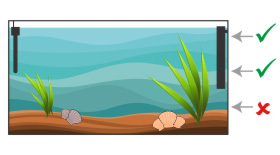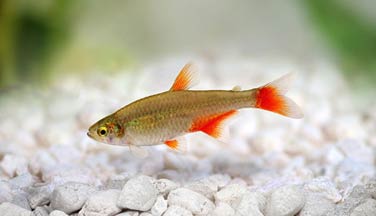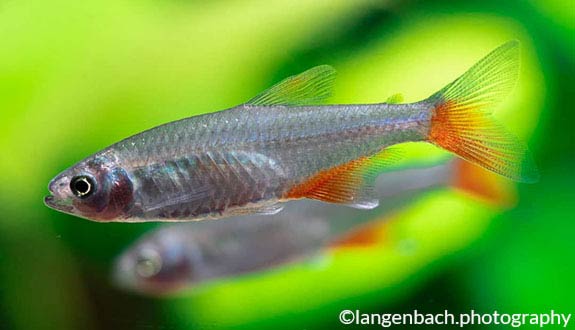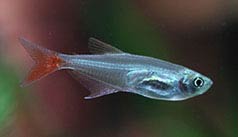

Alternative species (click on the thumbnail to see the card)
Names
Scientific name
Aphyocharax anisitsi
Aphyocharax affinis
Tetragonopterus rubropictus
Common name
Bloodfin tetra
Rotflossensalmler (DE)
Origin

Origin: Argentina
Biotope: Amazonian
Dimorphism

Male is more slender and has fine hooks to the anal fin (not very visible). Females are more squat
Group

Characidae
Volume

100 L / 22 imp gal / 26 US gal
Parameters

T°: 18 to 28°C or 64 to 82°F
pH: 6 to 8
Hardness: 5 to 30°dGH
Difficulty

Easy
Size

5 cm (2")
Longevity

5 years
Living zone

Middle and top
Individuals

8 or more
Food
How to feed the Bloodfin tetra?
Food
How to feed the Bloodfin tetra?
Omnivorous: this fish accepts all forms of food with preference for live prey. If possible, feed them in two or three times a day. For quantity, give them only what they can eat in 3 minutes or less with each meal.
Behavior
What kind of behavior does the Bloodfin tetra have?
Behavior
What kind of behavior does the Bloodfin tetra have?
It is a lively and active species that can swim very fast.
Peaceful and gregarious, the Red fins will live imperatively in groups. If Aphyocharax anisitsi is kept alone or if the group is too small, it becomes very shy and spends time hiding. In group, they are much safer and more daring, more active and spend a lot of time parading in the aquarium!
Sometimes you can observe an individual who separates from the group to explore a corner, but this behavior remains momentary and this individual will return to the group as soon as it feels threatened.
If they are kept in a too small water volume, they become irritable.
Cohabitation
Who can live with the Bloodfin tetra?
Cohabitation
Who can live with the Bloodfin tetra?
Pacific with all, it will flourish in a community aquarium (he does not pay much attention to other roommates).
However, be careful with the cohabitation with the wing species or the too slow species of which it could come to pinch the fins.
You can associate them with small Loricariidae, Rasboras or other Characidae. It will be necessary to be more careful with the cohabitation with the Corydoras because they can be frightened by too active fish.
Breeding
How to breed the Bloodfin tetra?
Breeding
How to breed the Bloodfin tetra?
Breeding sometimes occurs without the intervention of the aquarist. It can be done in a group.
Place in a spawning tank (20 L or 5 gal) equipped with a protective grid, at least one male and one female. The tray should be sunny and covered, with thin-leafed plants like Java moss. You can also install a small air filter. You will first separate the sexes and stimulate spawning before the introduction of parents feeding largely live prey. Temperature of 24°C (75°F) and KH lower then 4°. Once the group is introduced, continue to feed a lot until the appearance of eggs. Remove the parents immediately. A laying can range from 300 to 500 eggs. The incubation lasts 24 hours. The fry are very fearful and hide a lot, so they are hard to see!
Food for the fry: infusoria, nauplies artemia and cyclops.
Its aquarium
Which aquarium for the Bloodfin tetra?
Its aquarium
Which aquarium for the Bloodfin tetra?
It likes well-planted aquariums, hiding places and a dark substrate. However, it must have sufficient swimming space. Therefore, plant mainly on the periphery and add the shade of the floating plants. This fish will particularly like plants like Valisneria and Sagittaria. You can complete the decoration with twisted roots for a beautiful effect! Finally, add a few dried leaves, which will colour the water with a light brown, and replace the leaves every few weeks.
Remember that an aquarium that closely resembles the natural habitat of a fish, will make the fish less stressed, which will make it healthier and happier.
Its water must remain clean and it is necessary to change 25 to 50% of the water every 2 weeks. You can use a high flow filter because the red fins like the current.
His aquarium can do without heating, but Aphyocharax anisitsi will be more colorful in warmer water. A rather weak lighting will embellish your fish!
Finally, it is important to cover your aquarium because at the slightest fright, these fish are likely to jump outside the tank.
Good To know
Find all additional information!
Good To know
Find all additional information!

Aphyocharax anisitsi is quite robust, hardy and breeds easily. The disease is not usually a problem in a well maintained aquarium. It can therefore be proposed to beginners (it adapts to a relatively wide range of parameters).
Its original habitat makes it subject to strong variations in water parameters such as pH or temperature. Feel free to vary these settings from time to time to breedi ts natural conditions.
It differs from Prionobrama filigera by the presence of red on its fins anal and ventral.
Yours photos!
Comments
Sort by:
Please login to post comments


